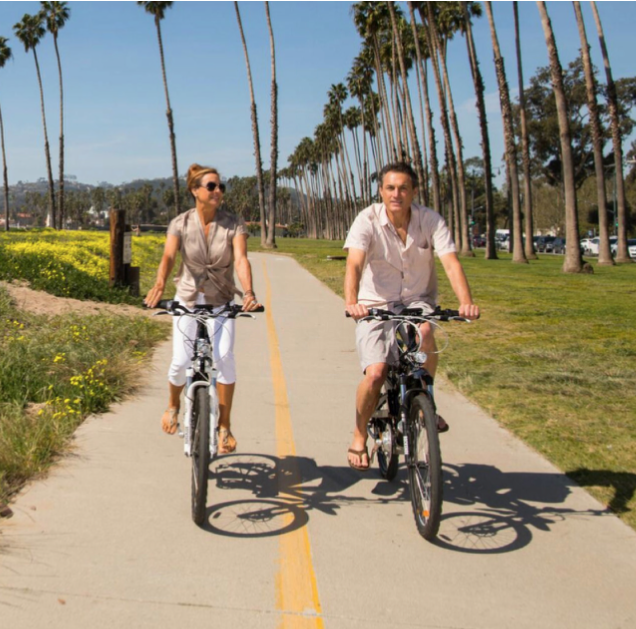Cycling 101: The Basics
Now that you’ve selected and purchased the perfect bike, you’re almost ready to hit the road. But before you do, there are a few basics you need to keep in mind.
Wearing your helmet is the #1 rule of bicycle safety.
One of the most comprehensive studies of the effectiveness of bike helmets found that head and face injuries are among the most common and dangerous risks of cycling. Fortunately, researchers working on this study found that wearing helmets is an incredibly simple and effective solution. They wrote: “Helmets provide a 63 to 88% reduction in the risk of head, brain and severe brain injury for all ages of bicyclists. Helmets provide equal levels of protection for crashes involving motor vehicles (69%) and crashes from all other causes (68%). Injuries to the upper and mid facial areas are reduced 65%.”
Along with wearing your helmet, always pedal defensively. Remain on the lookout for potential dangers and watch out for other cyclists, pedestrians, and cars. In particular, watch out for car doors that might unexpectedly open in front of you, and for turning cars that might not see you and inadvertently cut you off.
Finally, whenever you can, try to ride in designated bike lanes or on bike paths away from streets. If this isn’t possible, follow the rules of the road (outlined below).
Other tips for remaining safe on your bike include:
- Install a bell or horn on your handlebars to alert people in your way.
- When riding at night, use a front light (white) and a rear light (red). At the very least, be sure your bike has reflectors in a place that’s visible to car drivers and other cyclists.
- Don’t talk on your phone or text while biking.
- Ride in a straight line.
- Try to avoid car drivers’ blind spots. When possible, making eye contact with drivers can be a good way to ensure that they see you.
- Always ride with at least one hand on your handlebars.
- Consider installing a rear view mirror on your handlebars or helmet so you can see traffic coming up behind you.
Rules of the Road
In general, cyclists on the road should act like a car. If you’re ever in doubt about the rules, do what you would do if you were driving a car.
Here are some of the most important rules to follow:
- Avoid riding on the sidewalk. Instead, ride in a designated bike lane. If you’re in an area where there are no bike lanes, ride with the flow of traffic on the far right side of the road.
- Bicycles are not allowed on freeways and large highways in most locales; stick to local roads, city streets, and small highways with minimal traffic.
- Follow all traffic signals and road signs, including red lights, one way road signs, and other common traffic signals.
- Signal before turning. When turning left, hold your left arm straight out, pointing in the direction you’re turning. When turning right, hold your left hand up in the air at a right angle. Most places also allow you to hold your right arm straight out to signal a right turn.
- In many places, cyclists are legally required to use lights at night. Even if it’s not a law, lights are always a good idea when riding at night.
- Look up specific state and municipal traffic laws in your location.
Basic Bicycle Maintenance
Bike maintenance is an important piece to becoming a safe and responsible cyclist. Keeping your bike in good working order will improve safety and help you have an enjoy- able cycling experience. Before each ride, give your bike the “ABC Quick Check”:
| Air | Give your tires a visual check and press down on them with your hand to ensure they’re not flat. |
| Brakes | Squeeze your brake levers to be sure your brakes are working. |
| Chain & Cranks | Look at your chain to be sure it’s intact and free of debris. Use your hands to push and pull on your cranks (the metal arms attached to your pedals) to be sure they’re tight and secure—there should be no play in your cranks. |
| Quick Release | If your wheels have quick release skewers (most newer bikes do), be sure the levers are in the locked position. |
| Check Your Ride | Use your first few pedal strokes to be sure everything is working well: squeeze your brakes, shift through a few gears, and be sure everything feels OK. |
If you notice anything wrong with your bike, contact the manufacturer for online brands or take it to your local bike shop for diagnosis and repair. And if you’re interested in learning about doing your own bicycle repairs, check your local shop or bicycle cooperative for classes, watch instructional videos on YouTube, or look for bicycle repair books at your library or local bookstore.
For more information, see:
“Basic Bike Check,” The League of American Bicyclists.
“Basic Bike Check (Just Remember: ABC Quick Check).” The League of American Bicyclists.

